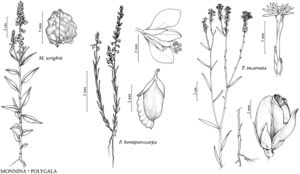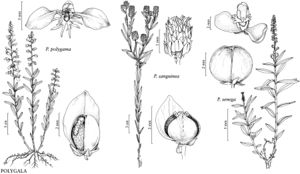Polygala
Sp. Pl. 1: 701. 1753.
| Taxon | Illustrator ⠉ | |
|---|---|---|
 | Monnina wrightii Polygala hemipterocarpa Polygala incarnata | |
 | Polygala polygama Polygala sanguinea Polygala senega |
Herbs, annual, biennial, or perennial, or subshrubs [lianas, shrubs, trees], single to multistemmed. Stems mostly erect, sometimes lax to decumbent or prostrate [mat-forming], usually not glaucous, usually glabrous, sometimes pubescent or glabrate. Leaves basal and/or cauline, sometimes rosulate; usually alternate, sometimes opposite or whorled; sessile, subsessile, or petiolate; usually uniform; blade surfaces glabrous or pubescent. Inflorescences terminal [axillary or leaf-opposed], racemes, sometimes in cymose-panicles, or nearly spikes, [corymbs, fascicles, or 1–5-flowered], usually not interrupted; peduncle present or absent; bracts deciduous or persistent. Pedicels usually present, usually glabrous. Flowers white, cream, green or greenish, pink, purple, reddish purple, blue, yellow, or orange, chasmogamous (some cleistogamous in P. crenata, P. lewtonii, and P. polygama), 1–9 (–10) mm; sepals persistent, glabrous (pubescent in P. alba and P. vulgaris), margins entire, sometimes ciliate or ciliolate; wings persistent, 1–9 mm, glabrous (pubescent in P. alba), margins entire, sometimes ciliolate; keel crested, crest 2-lobed, often fimbriate (lobes subdivided into fingerlike lobes), glabrous (pubescent in P. alba); stamens (6–) 8 in chasmogamous flowers, fewer in cleistogamous flowers, not grouped; ovary 2-loculed (sometimes 1 abortive). Fruits capsules, dehiscent [indehiscent], margins winged or not, entire (crenately winged in P. crenata, erose-crenulate in P. hemipterocarpa), glabrous [pubescent]. Seeds coat without pits (except in P. hemipterocarpa, P. scoparioides, and P. watsonii), usually pubescent (hairs glochidiate in P. glochidata), usually arillate.
Distribution
North America, Mexico, West Indies, Central America, South America, Europe, Asia, Africa, Australia
Discussion
Species ca. 725 (31 in the flora).
Five non-native Polygala species have been reported for the flora area. Only P. vulgaris is truly naturalized; the other four, P. longicaulis Kunth, P. myrtifolia Linnaeus, P. paniculata Linnaeus, and P. serpyllifolia Hosé are historic waifs. Polygala serpyllifolia has been reported from Greenland (J. Devold and P. F. Scholander 1933) based on a single depauperate individual. Additional material has never been seen. Polygala paniculata was reported for Maryland by the USDA Plants database, but no specimens are known. It was reported also from Texas (D. S. Correll and M. C. Johnston 1970) but remains undocumented apart from a single specimen (Eggleston 17398, NY) collected in 1920 from Fort Davis in Jeff Davis County. Polygala myrtifolia is cultivated, especially in California and Florida, and is naturalized in Australia, Hawaii, and New Zealand. The USDA Plants website record for California is based on F. Hrusa et al. (2002), which was based on C. F. Smith (1976); however, the species was not listed by Smith (1998). Polygala longicaulis was collected only once, in 1917 from Jackson County, Alabama (ROCH). All four excluded, non-native species of Polygala are easily recognizable as part of the genus based on their fimbriate crests. They can be distinguished from the native Polygala species based on the following characters. Polygala longicaulis is separated by its obconic seeds densely covered in silky hairs, as well as the large, reddish to orangish resin dots medially on the sepals. Polygala myrtifolia would be the only shrubby Polygala in North America with a fimbriate crest. Polygala paniculata would look most similar to a robust P. glochidata, but lacks the glochidiate hairs on the seeds, usually has only the most proximal nodes with whorled leaves (often caducous by anthesis), and the stems are finely stipitate-glandular. Polygala serpyllifolia is very much like P. vulgaris but the proximal leaves are opposite or subopposite.
Selected References
None.
Lower Taxa
Key
| 1 | Capsule margins on abaxial locule not winged, adaxial locule longer and winged (sometimes not or obscurely winged in P. watsonii); seed coats with rows of pits (0.05 mm diam.); flowers white; racemes loosely flowered, cylindric or subcapitate; Arizona, New Mexico, Texas. | > 2 |
| 2 | Stems glabrous (rarely with a few scattered hairs). | Polygala hemipterocarpa |
| 2 | Stems puberulent or glabrate. | > 3 |
| 3 | Wing sepals (2.4–)2.7–4.5 mm; racemes cylindric (flowering portion may appear subcapitate from deciduous fruit), (1–)1.5–7.8 × 0.4–0.8 cm. | Polygala scoparioides |
| 3 | Wing sepals (3.5–)4–6 mm; racemes subcapitate, 0.5–1.4(–2.5) × 1 cm. | Polygala watsonii |
| 1 | Capsule margins not winged or narrowly and equally winged on both locules; seed coats without pits; flowers usually cream, green or greenish, pink, purple, reddish purple, blue, yellow, or orange, seldom white; racemes often densely flowered, sometimes spikelike or nearly so, capitate or cylindric; mostly e, n North America. | > 4 |
| 4 | Pedicels winged; flowers usually yellow, orange, green, or greenish, rarely white; racemes in cymose panicles or capitate. | > 5 |
| 5 | Racemes in cymose panicles, ± flat-topped; basal leaf blades obovate, spatulate, narrowly elliptic, linear-lanceolate, or linear, sometimes withered or nearly so at anthesis. | > 6 |
| 6 | Corollas pale yellowish apically, wing sepals white, cream, or, sometimes, greenish tinged; pedicels 0.6–1.2 mm. | Polygala balduinii |
| 6 | Corollas and wing sepals bright yellow; pedicels (1–)1.3–4 mm. | > 7 |
| 7 | Basal leaf blades linear-lanceolate to linear, forming large, persistent rosette; biennials, 4–12 dm. | Polygala cymosa |
| 7 | Basal leaf blades obovate or spatulate to narrowly elliptic, usually absent at anthesis; annuals or biennials, 1.5–4(–5) dm. | Polygala ramosa |
| 5 | Racemes solitary (not in panicles), capitate; basal leaf blades usually obovate, oblanceolate, linear-oblanceolate, or spatulate, rarely elliptic, often persistent. | > 8 |
| 8 | Flowers bright yellow to orange, drying pale yellow to dark greenish brown. | > 9 |
| 9 | Flowers bright orange, usually drying pale yellow; racemes (0.8–)1.2–2 cm diam. | Polygala lutea |
| 9 | Flowers bright yellow, drying pale yellow to dark greenish brown; racemes 1.8–2.5 cm diam. | Polygala rugelii |
| 8 | Flowers lemon yellow, greenish yellow, or green, sometimes drying green or yellowish green. | > 10 |
| 10 | Flowers lemon yellow to greenish yellow; wing sepals elliptic to oblong- lanceolate, tips 0.7–1.6 mm, apices involute; seeds 0.8–1.8 mm. | Polygala nana |
| 10 | Flowers green or greenish yellow; wing sepals usually lanceolate, sometimes oblong-lanceolate, tips 0.5–0.9 mm, apices usually flat to slightly involute; seeds 1.9–2.3 mm. | Polygala smallii |
| 4 | Pedicels not winged; flowers white, cream, green or greenish, pink, purple, reddish purple, or blue, not bright yellow or orange; racemes solitary (not in cymose panicles), sometimes spikelike or nearly so, cylindric, cylindric-conic, or capitate. | > 11 |
| 11 | Seed hairs glochidiate; leaves whorled (at least proximally); Arizona. | Polygala glochidata |
| 11 | Seed hairs not glochidiate; leaves usually whorled or alternate, rarely opposite or subopposite; widespread. | > 12 |
| 12 | Leaves whorled, at least at proximalmost 1 or 2 nodes. | > 13 |
| 13 | Perennials, multi-stemmed, with thickened caudices; flowers white or greenish white. | > 14 |
| 14 | Capsules ovoid, ellipsoid, or oblong, 1.3–1.6 mm diam.; w North America. | Polygala alba |
| 14 | Capsules subglobose to broadly ellipsoid, (1.2–)2–3 mm diam.; se United States. | Polygala boykinii |
| 13 | Annuals, single-stemmed (usually branched distally), with slender taproots or fibrous roots; flowers mostly pink or purple, sometimes white, greenish, or greenish white. | > 15 |
| 15 | Racemes spikelike or nearly so, cylindric, cylindric-conic, or conic; bracts deciduous; pedicels 0–1(–2) mm. | > 16 |
| 16 | Seeds glabrous. | Polygala leptostachys |
| 16 | Seeds pubescent. | Polygala verticillata |
| 15 | Racemes mostly capitate or apically rounded, sometimes cylindric; bracts persistent; pedicels (0.7–)1–2.4 mm. | > 17 |
| 17 | Wing sepals ovate to deltate, apices acuminate, often strongly cuspidate. | Polygala cruciata |
| 17 | Wing sepals ovate to ovate-oblong or ovate-oblanceolate, apices acute, short-mucronate. | > 18 |
| 18 | Wing sepals 1.5–2.5 mm wide; leaf blades 1–4(–7) mm wide. | Polygala brevifolia |
| 18 | Wing sepals 1.3–2 mm wide; leaf blades 0.5–1 mm wide. | Polygala hookeri |
| 12 | Leaves mostly alternate, proximal leaves sometimes opposite or whorled (in P. incarnata, P. lewtonii, and P. polygama). | > 19 |
| 19 | Cleistogamous flowers present, usually below, rarely just above, soil surface, sometimes in proximal leaf axils later in season; racemes loosely cylindric; short-lived perennials, biennials, or annuals, usually multi-stemmed, sometimes single-stemmed. | > 20 |
| 20 | Capsule margins winged. | Polygala crenata |
| 20 | Capsule margins not winged. | > 21 |
| 21 | Capsules ellipsoid or oblong, 2.5–3.5 × 1–1.5 mm, length 2–3 times width; flowers 6–8 mm; non-wing sepals 0.8–1.1 mm. | Polygala lewtonii |
| 21 | Capsules ellipsoid or globose-ovoid, 2–4 × 2–3 mm, length less than 2 times width; flowers 4–6 mm; non-wing sepals 1.3–2.5 mm. | Polygala polygama |
| 19 | Cleistogamous flowers absent; racemes sometimes spikelike or nearly so, often densely capitate or cylindric, sometimes cylindric-conic; mostly annuals, single-stemmed, sometimes perennials and single- or multi-stemmed. | > 22 |
| 22 | Leaf blades (1.5–)8–35 mm wide, margins often appearing serrulate (toothlike projections associated with marginal cilia. | Polygala senega |
| 22 | Leaf blades 0.3–2(–5.5) mm wide (rarely more than 4 mm); margins entire. | > 23 |
| 23 | Capsule margins narrowly winged; short-lived perennials, usually multi-stemmed (rarely 1 or few-stemmed) from small caudices; British Columbia, Michigan, Oregon. | Polygala vulgaris |
| 23 | Capsule margins not winged; annuals (sometimes perennial in P. setacea), single-stemmed, from taproots; s, e North America. | > 24 |
| 24 | Wing sepals less than 1/2 as long as keel petals; stems glaucous; arils scarcely lobed. | Polygala incarnata |
| 24 | Wing sepals usually (sub)equaling or exceeding keel petals, rarely slightly shorter; stems not or seldom glaucous; arils usually lobed, rarely vestigial. | > 25 |
| 25 | Leaf blades subulate scales, 0.5–1.6(–2) mm. | Polygala setacea |
| 25 | Leaf blades linear, linear-oblong, spatulate, oblanceolate, elliptic, linear-subulate, or subfiliform, 3–25(–40) mm. | > 26 |
| 26 | Wing sepals 1.5–2 times longer than keel petals; aril lobes (1/2–)2/3–nearly as long as seed. | Polygala sanguinea |
| 26 | Wing sepals equaling or slightly longer than keel petals (shorter in P. chapmanii, sometimes slightly shorter in P. mariana and P. nuttallii); aril lobes to 1/8–1/2 length of seed or vestigial. | > 27 |
| 27 | Bracts persistent (P. chapmanii often also with scattered deciduous ones). | > 28 |
| 28 | Racemes 0.4–0.7 cm diam.; wing sepals 2–3 mm; pedicels 0.5(–1) mm. | Polygala nuttallii |
| 28 | Racemes 0.6–1.3 cm diam.; wing sepals 2.5–5 mm; pedicels 0.7–2.8 mm. | > 29 |
| 29 | Wing sepals 2.5–3.3(–3.8) mm; capsules 1.5–2.3 mm. | Polygala chapmanii |
| 29 | Wing sepals 3–5 mm; capsules (1.7–)2.5–3 mm. | Polygala curtissii |
| 27 | Bracts deciduous (rarely a few persistent and scattered). | > 30 |
| 30 | Flowers white. | Polygala verticillata |
| 30 | Flowers usually pink or purple, rarely white. | > 31 |
| 31 | Racemes cylindric, 1.5–13 × 0.5–0.6 cm; flowers 1.6–2.2 mm; pedicels 0.8–1 mm. | Polygala appendiculata |
| 31 | Racemes capitate, (0.5–)1–3.5 × 0.6–1.1 cm; flowers 4–5.7 mm; pedicels 1.5–3.5 mm. | Polygala mariana |